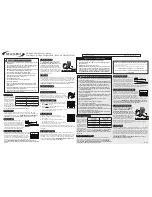
5
Unless you have special blades designed to be sharpened primarily on one side of the
edge (such as Asian Kataba blades) you will want to sharpen equally in the right and left
slots of each stage that you use. This will insure that the facets on each side of the edge
are of equal size and that the edge will cut straight at all times.
When sharpening in either stage the knife should on sequential strokes be
pulled
alternately through the left slot and the right slot of that Stage.
Generally a few
pairs of pulls (alternating in the left and right slots) will be adequate in each stage (see
subsequent sections for more detail). Always operate the sharpener from the front side
with the switch facing you. Hold the blade horizontal and level, slide it down between
the plastic spring and the guide plane while pulling it toward you at a uniform rate as
it contacts the sharpening or honing disk. You will be able to feel and hear the contact
with the disk as it is made. Always keep the blade moving uniformly through each stage;
do not stop the pull in mid stroke. The time for each sharpening stroke can be less for
shorter blades and more for longer blades.
Never operate the sharpener from the back side.
Use just enough downward pressure when sharpening to insure uniform and consistent
contact of the blade with the abrasive disks on each stroke. The sharpening pressure is
controlled by built in springs. Additional pressure is unnecessary and will not speed the
sharpening process. Avoid cutting into the plastic enclosure. Accidental cutting into the
enclosure will not functionally impact operations of the sharpener or damage the edge.
Figure 1 below identifies each of the two stages as described further in the follow-
ing sections.
Figure 2. Typical kitchen knife.
Heel
Bolster
Handle
Edge
Tip
Figure 1. Model 314 Diamond Hone
®
Sharpener.
Stage 1
Stage 2
Positioning
Spring






























